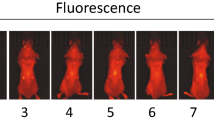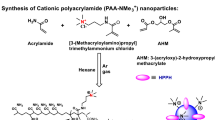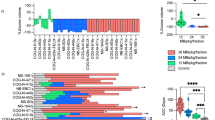Abstract
Magnetic resonance spectroscopy in situ was used to study changes in phosphorus 31 metabolism after photodynamic therapy (PDT) of transplanted HeLa cell tumours. Tumours were irradiated 2 h after administration of ATX-S10 (8-formyloximethylidene-7-hydroxy-3-ethenyl-2,7,12,18, tetramethyl-porphyrin-13,17-bispropionil aspartate), a new photosensitizer and chlorin derivative. Nuclear magnetic resonance spectra were measured prior to illumination and 1, 3, 7, 14, 21 and 28 days after PDT on each mouse. A drastic decrease in adenosine triphosphate (ATP) and a concomitant increase in inorganic phosphate (Pi) were evident on the first day after PDT in all cases. The β-ATP/total phosphate (P) ratio was 0.64 ± 0.29% (average ± s.d.) in complete response, 0.67 ± 0.30% in recurrence and 2.45 ± 0.93% in partial response. Comparison of this ratio to the histological findings revealed that the β-ATP/total P ratio reflects the HeLa cell tumours which survived PDT. In other words, partial response on the one hand was distinguished from complete response and recurrence on the other with this ratio 1 day after PDT (P < 0.05). In addition, the ratio of phosphomonoester (PME) to Pi rose beyond 1.0 when macroscopic recurrence occurred, while it stayed under 1.0 in complete response. This finding suggests that the recurrence of HeLa cell tumours can be detected by the PME/Pi ratio.
Similar content being viewed by others
Article PDF
Change history
16 November 2011
This paper was modified 12 months after initial publication to switch to Creative Commons licence terms, as noted at publication
References
Bremner, J. C. M., Bradley, J. K., Stratford, I. J. & Adams, G. E. (1994) Magnetic resonance spectroscopic studies on ‘real-time’ changes in RIF-1 tumor metabolism and blood flow during and after photodynamic therapy. Br J Cancer 69: 1083–1087.
Ceckler, T. L., Bryant, R. G., Penny, D. P., Cibson, S. L. & Hilf, R. (1986) 31P NMR spectroscopy demonstrates decreased ATP levels in vivo as an early response to photodynamic therapy. Biochem Biophys Res Commun 140: 273–279.
Ceckler, T. L., Gigson, S. L., Kennedy, S. D., Hilf, R. & Bryant, R. G. (1991) Heterogeneous tumor response to photodynamic therapy assessed by in vivo localised 31P NMR spectroscopy. Br J Cancer 63: 916–922.
Chapman, J. D., McPhee, M. S., Walz, N., Chemer, M. P., Stobbe, C. C., Soderlind, K., Arnfield, M., Meeker, B. E., Trimble, L. & Allen, P. S. (1991) Nuclear magnetic resonance spectroscopy and sensitizer-adduct measurements of photodynamic therapy-induced ischemia in solid tumors. J Natl Cancer Inst 83: 1650–1659.
Chopp, M., Farmer, H., Hetzel, F. & Schaap, A. P. (1987) In vivo 31P NMR spectroscopy of mammary carcinoma subjected to subcurative photodynamic therapy. Photochem Photobiol 46: 819–822.
Chopp, M., Hetzel, F. W. & Jiang, Q. (1990) Dose-dependent metabolic response of mammary carcinoma to photodynamic therapy. Radiation Res 121: 288–294.
Daly, P. F. & Cohen, J. S. (1989) Magnetic resonance spectroscopy of tumors and potential in vivo clinical application: a review. Cancer Res 49: 770–779.
Daly, P. F., Lyon, R. C., Faustino, P. J. & Cohen, J. S. (1987) Phospholipid metabolism in cancer cells monitored by 31P NMR spectroscopy. J Biolog Chem 262: 14875–14878.
Dewhirst, M. W., Sostman, H. D., Leopold, K. A., Charles, H. C., Moor, D., Burn, R. A., Tucker, J. A., Harrelson, J. M. & Oleson, J. R. (1990) Soft-tissue sarcomas; MR imaging and MR spectroscopy for prognosis and therapy monitoring. Radiology 174: 847–853.
Evanochko, W. T., Ng, T. C., Glickson, J. D., Durant, J. R. & Corbett, T. H. (1982) Human tumors as examined by in vivo 31P NMR in athymic mice. Biochem Biophs Res Commun 109: 1346–1352.
Fisher, A. M. R., Murphree, A. L. & Gomer, C. J. (1995) Clinical and preclinical photodynamic therapy. Lasers Surg Med 17: 2–31.
Foote, C. S. (1990) Chemical mechanisms of photodynamic action. In Proc. SPIE Institute on Advanced Optical Technologies on Photodynamic Therapy. SPIE 6: 115–126.
Gibson, S. L. & Hilf, R. (1983) Photosensitization of mitochondrial cytochrome c oxidase by hematoporphyrin derivative and related porphyrins in vitro and in vivo. Cancer Res 43: 4191–4197.
Gibson, S. L., Murant, R. S. & Hilf, R. (1988) Photosensitizing effect of hematoporphyrine derivative and photofrin II on the plasma membrane enzymes 5´-nucleotidase, Na+ K+ -ATPase, and Mg2+ -ATP ase in R3230 AC mammary adenocarcinomas. Cancer Res 48: 3360–3366.
Hashimoto, Y. & Sakata, I. (1994) Photodynamic therapy for transplantable human esophageal cancer (ES4) of nude mice with excimer dye laser and ATX-S10. J Jpn Society Laser Med 15: 1–7.
Hayashi, Y., Yoshida, T. O., Nishiwaki, M., Matsuzawa, E., Yicheng, L. & Ohta, I. (1998). Effective mechanisms of ATX-S10, a new photosensitizer, against HeLa tumors in nude mice. Jpn J Chemother (in press)
Henderson, B. W. & Dougherty, T. J. (1992) How does photodynamic therapy work?. Photochem Photobiol 55: 145–157.
Hilf, R., Smail, D. B., Murant, R. S., Leakey, P. B. & Gibson, S. L. (1984) Hematoporphyrine derivative-induced photosensitivity of mitochondrial succinate dehydrogenase and selected cytosolic enzymes of R3230AC mammary adenocarcinomas of rat. Cancer Res 44: 1483–1488.
Hilf, R., Murant, R. S., Narayanan, U. & Gibson, S. L. (1986) Relationship of mitochondrial function and cellular adenosine triphosphate levels to hematoporphyrin derivative-induced photosensitization in R3230AC mammary tumors. Cancer Res 46: 211–217.
Hilf, R., Penney, D. P., Ceckler, T. L. & Bryant, R. G. (1987) Early biochemical responses to photodynamic therapy monitored by NMR spectroscopy. Photochem Photobiol 46: 809–817.
Hua, Z., Gibson, S. L., Foster, T. H. & Hilf, R. (1995) Effectiveness of δ-aminolevulinic acid-induced protoporphyrin as a photosensitizer for photodynamic therapy in vivo. Cancer Res 55: 1723–1731.
Kato, H. (1996) History of photodynamic therapy: past, present, and future. Jpn J Chemother 23: 8–15.
Mattiello, J., Evelhoch, L., Brown, E., Schaap, A. P. & Hetzel, F. W. (1990) Effect of photodynamic therapy on RIF-1 tumor metabolism and blood flow examined by 31P and 2H NMR spectroscopy. NMR Biomed 3: 64–70.
Nakajima, S., Hayashi, H., Sakata, I. & Takemura, T. (1993) New photosensitizer- ATX-S10-having type 1 photoreaction. Igaku no Ayumi 164: 187–188.
Naruse, S., Horikawa, Y., Tanaka, C., Higashi, T., Sekimoto, H., Ueda, S. & Hirakawa, K. (1986) Evaluation of the effects of photoradiation therapy on brain tumors with in vivo 31P MR spectroscopy. Radiology 160: 827–830.
Negendank, W. (1992) Studies of human tumors by MRS: a review. NMR Biomed 5: 303–324.
Ng, T. C., Evanochko, W. T., Hiramoto, R. N., Ghanta, V. K., Durant, J. R. & Glickson, J. D. (1982) 31P NMR spectroscopy of in vivo tumors. J Mag Res 49: 271–286.
Perlin, D. S., Murant, R. S., Gibson, S. L. & Hilf, R. (1985) Effects of photosensitization by hematoporphyrin derivative on mitochondrial adenosine triphosphate-mediated proton transport and membrane integrity of R3230AC mammary adenocarcinomas. Cancer Res 45: 653–658.
Steen, R. G. (1989) Response of solid tumors to chemotherapy monitored by in vivo 31P nuclear magnetic resonance spectroscopy: a review. Cancer Res 49: 4075–4085.
Takemura, T., Nakajima, S. & Sakata, I. (1993) Photophysicochemical properties of photosensitizer ATX-70, ATX-S10 and fluorescent diagnostic agent HAT-D01. J Jpn Society Laser Med 14: 21–29.
Weishaupt, K. R., Gomer, C. J. & Dougherty, T. J. (1976) Identification of singlet oxygen as the cytotoxic agent in photo-inactivation of murine tumor. Cancer Res 36: 2326–2329.
Author information
Authors and Affiliations
Rights and permissions
From twelve months after its original publication, this work is licensed under the Creative Commons Attribution-NonCommercial-Share Alike 3.0 Unported License. To view a copy of this license, visit http://creativecommons.org/licenses/by-nc-sa/3.0/
About this article
Cite this article
Nishiwaki, M., Fujise, Y., Yoshida, T. et al. Evaluation of the effects of photodynamic therapy with phosphorus 31 magnetic resonance spectroscopy. Br J Cancer 80, 133–141 (1999). https://doi.org/10.1038/sj.bjc.6690332
Received:
Revised:
Accepted:
Published:
Issue date:
DOI: https://doi.org/10.1038/sj.bjc.6690332



